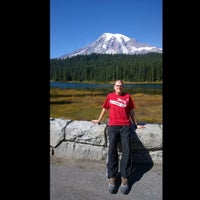

The Nisqually Entrance is located at the southwest corner of the park (and where many of the listed activities below are accessed.) From the Seattle airport, it is south and slightly east and takes just under 2 hours to the Nisqually Entrance. To access the park, you’ll want to fly into Seattle (SEA) airport. This beautiful national park is located in the state of Washington. It is no extra cost to you.įind the best things to do in Mt Rainier National Park!ĭon’t forget your rental car! Find great prices here from Seattle Airport What You Need to Know About Mt Rainier National Park Where is Mount Rainier National Park? As an Amazon (and other networks) Associate, I earn from qualifying purchases. At 5.0 miles, the trail exits adjacent the restrooms at Narada Falls.Let’s Jet, Kids! uses affiliate links. Over the next quarter mile, the river churns and drops through a beautiful sequence of cascades, making photography stops almost mandatory. You need to cross the bridge and the road to resume the trail at a small waterfall just below the bridge. This one has two-way traffic with limited sight distance. Cross the river on a wooden bridge then descend to another road crossing. Almost immediately you reach the Paradise River and the first of many pleasant riverside viewpoints. Cross it and pick up the trail at the far right of the wide gravel pullout. From here, the route is the same for either loop.įollow the sign toward Paradise, soon coming to a road. Follow this route, which is mostly level with limited views and occasional ruts, to a junction at 3.8 miles with the other Lakes Trail. Go left on the High Lakes Trail (or Lakes High Trail as the sign reads).

Pass a small tarn to reach another junction at 2.7 miles. This is an airy precipice with an outstanding 180-degree view including Stevens Canyon to the east, sparkling Louise Lake below, and the magnificent Tatoosh Range dominating the southern horizon. Back in shady forest, climb on graveled soil to 2.5 miles, where the trail breaks out at Faraway Rock. Go left on the trail also signed as “Lakes Trail”. After 400 yards of pavement, follow the trail away from the highway to a junction at 2.0 miles. To complete the recommended 5-mile loop, continue past the middle of the first lake, where the trail becomes a raised paved walkway beside the road. (This junction offers a loop option of 3 miles.) At a junction with the “Lakes Trail”, go right and round the corner to the first and largest of the Reflection Lakes at 1.5 miles. Climb steadily to 0.8 mile, where you crest over a small pass and begin a gentle descent.Īt 1.3 miles, cross the Stevens Canyon Road and pick up the trail on the opposite side. The trail is lined with vegetation, predominantly vanilla leaf, blueberries, and ferns. Go left and start climbing through pleasant shaded forest. At 0.2 mile is a ‘T’ junction with the Wonderland Trail. Swirling mists can make the viewing area wet at any time of day.Ĭontinue downhill, leaving the crowds behind. The falls are best seen after mid-morning, when they can be fully illuminated on sunny days. Often damp, the trail drops moderately steeply 0.1 mile to a prominent viewpoint.
REFLECTION LAKE PACKWOOD FREE
Obtain a free copy of the “Paradise Area Trails” map from the Longmire Wilderness Information Center or Paradise Visitor Center to make this route even easier to follow.įrom the Narada Falls parking lot, cross the beautiful stone bridge and start downhill on the well-defined trail. But you can extend the route into a loop featuring an unobstructed view of the Tatoosh Range from a rocky bluff, and an up-close experience of the awe-inspiring whitewater cascades of the Paradise River. Hiking the trail between the Narada Falls viewpoint and Reflection Lakes is pleasant enough.


 0 kommentar(er)
0 kommentar(er)
